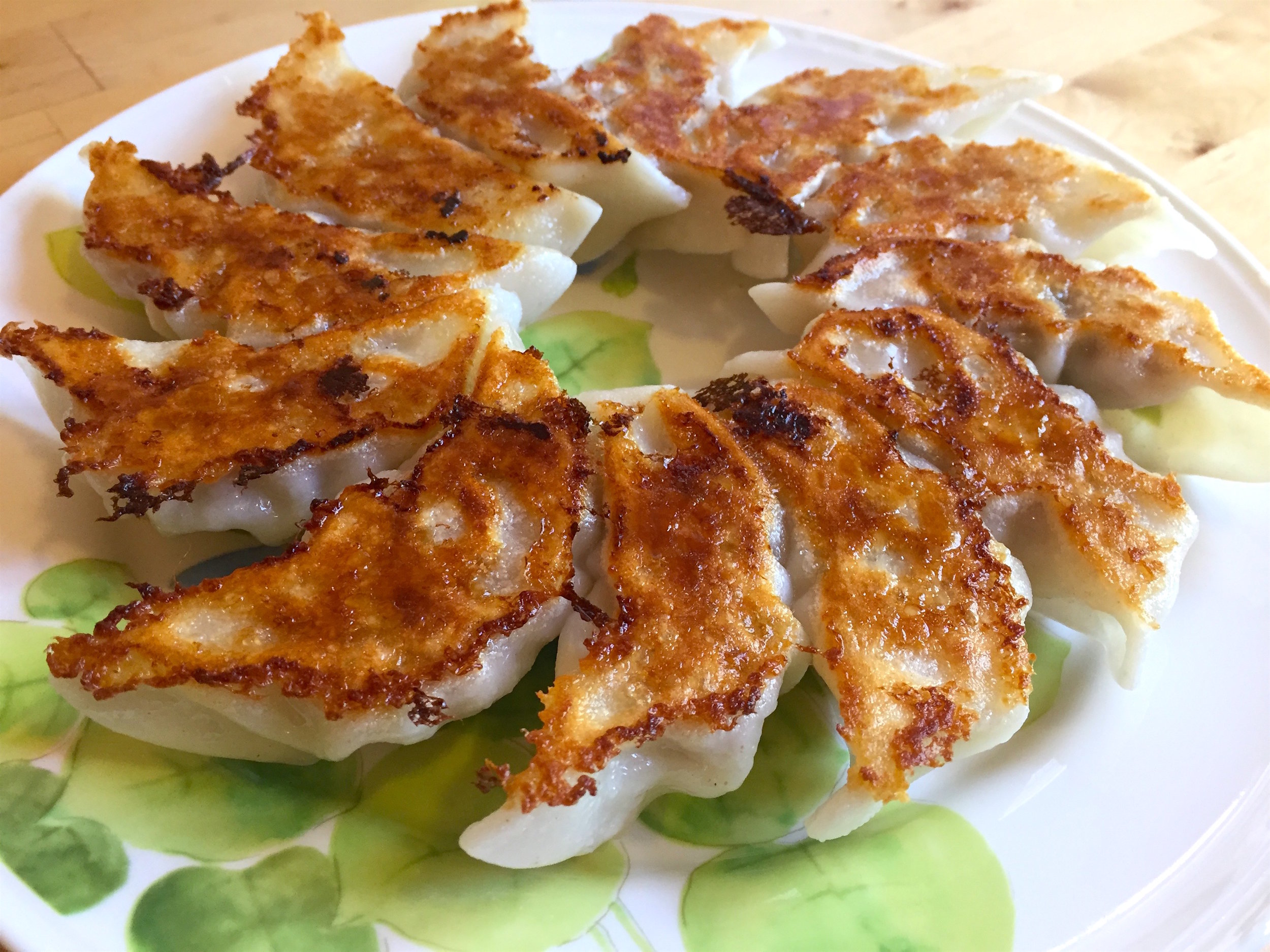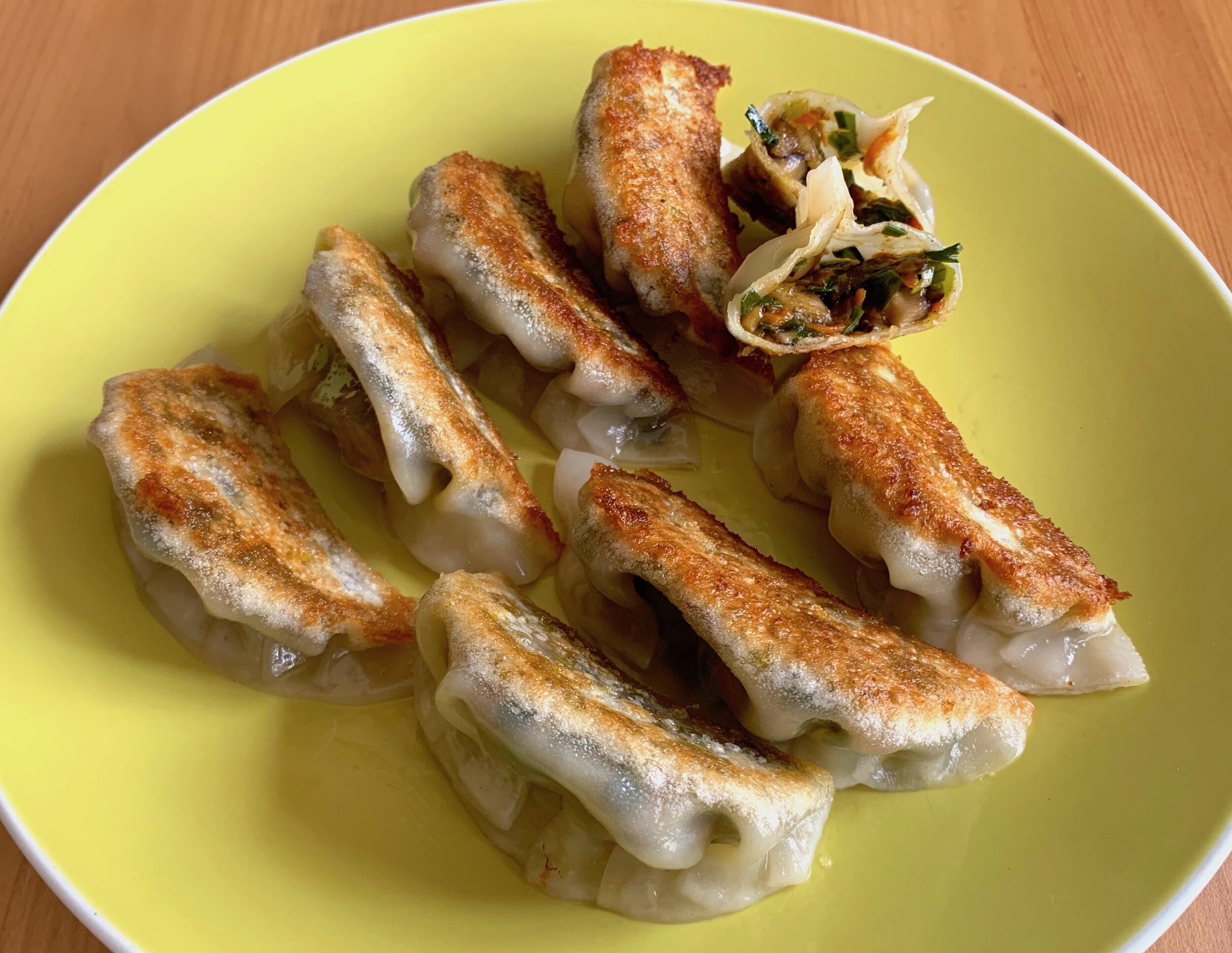Chinese Spring Rolls

春卷 (Chun Juan)
The spring roll (春卷) is perhaps one of the most globally recognized Chinese culinary inventions, served as an appetizer or as part of a dim sum meal. Traditionally served during Chinese New Year, when winter turns to spring [1], the rolls get their name from the multitude of fresh spring vegetables crammed inside. Today, of course, spring rolls are enjoyed year-round. There are many types of spring rolls, stuffed with different combinations of vegetables and meat and typically wrapped in a thin pastry and fried [2].
Unfortunately, many of the spring rolls you find in restaurants today skimp on the vegetables, leaving you with a greasy roll which is more wrapper than filling. Homemade spring rolls have the potential to be much tastier. They are not difficult to make, and can be stashed in the freezer to be fried up at your convenience! Our recipe is for a classic Cantonese version, stuffed with cabbage, mushrooms, and pork.
Ingredients
1 lb ground pork
8 oz Taiwanese cabbage, shredded
2 carrots, shredded
6 oz shiitake mushrooms, diced
4 cloves garlic, minced
1 inch ginger, minced
1 tbsp soy sauce
½ tsp white pepper
Salt to taste
24 spring roll wrappers
Cornstarch
Vegetable oil
First, let us prepare our vegetables. To ensure a uniform filling, the cabbage, carrots, and mushrooms must all be cut into very small pieces. Finely shred the cabbage into thin pieces no longer than about 2 inches. Shred the carrots using either a box grater or mandolin. Chop the shiitake mushrooms into a 1 cm dice, and finely mince the ginger and garlic.
With all the vegetables chopped, we can turn our attention to the pork. Ground pork usually contains more than enough fat to cook the meat, but this fat must first be rendered. Place one pound of ground pork in a large, cold skillet and heat it on low. We want to render enough fat to coat the skillet, then turn the heat up to medium-high. While the skillet comes to temperature, break up the ground pork to form a relatively even layer, sprinkle over white pepper, and add 1 tablespoon soy sauce. Toss to combine, breaking the ground pork up into small pieces.
Cook the pork for 5 minutes or until browned, then add the minced ginger and garlic. Fry the aromatics for 30 seconds or until fragrant, then add the cabbage, carrots, and mushrooms. Stir-fry the vegetables with the pork for about 10 minutes, or until the vegetables have wilted and most of the moisture has been cooked out. It is critical to make the filling as dry as possible, to avoid waterlogging the wrappers. By the time you finish cooking the filling, the bottom of the skillet should be dry when you draw a spatula across the skillet.
When the filling is done, season with salt to taste, then remove the filling from the skillet and place in a large bowl. Let the filling cool to room temperature, at least 1 hour, before wrapping. This is again to avoid waterlogging, as wrapping a hot filling will trap steam inside the roll. You can make the filling a day ahead of wrapping, and keep the filling in the refrigerator until ready to use.
Now, onto wrapping. On a clean table or counter, prepare a workspace for assembling the spring rolls. You can find spring roll wrappers in most Asian supermarkets. Do not pick up egg roll wrappers if you are intending to make spring rolls—egg roll wrappers are much thicker and are not good substitutes. The spring roll wrappers, if frozen, should be fully thawed. It is important to stop the wrappers from drying out, so depending on how fast you can work, and how humid the air is, it is often a good idea to keep the wrappers covered before wrapping, either with plastic wrap or a clean tea towel. A towel is also useful for drying your fingers. Mix a bit of cornstarch with some cold water to form a cornstarch slurry. We will use this slurry for sealing the spring rolls. Prepare a landing zone for the completed rolls. If you plan on cooking them all immediately, just go and pile the rolls up on a plate, but if you are planning on freezing the spring rolls, prepare a plate, cutting board, or sheet pan covered in plastic wrap or parchment paper. The rolls should be placed in a single layer with a small amount of distance between them so they freeze individually.
One wraps a spring roll the same way one would wrap a small burrito. Place a single wrapper on a flat surface, with one corner facing you. Lay about 2 tablespoons of the filling into a rectangle 3-4 inches wide, close to the corner facing you. The dimensions of the rectangle should be approximately the dimensions of the completed roll. Fold the left and right sides of the wrapper over, creasing at the ends of the rectangle of filling, so the entire assembly is of uniform width. Then begin to roll away from you, forming a cigar shape. Be sure to keep the roll very tight, so there is no air inside the spring roll. Air sealed inside the spring roll will expand rapidly when heated, which can cause the roll to burst when fried. When you reach the top corner of the roll, use your finger to paint the top edge with cornstarch slurry, like you would an envelope. The cornstarch slurry acts as a glue, sealing the spring roll as you finish wrapping. Once all the spring rolls are wrapped, either fry them immediately or freeze them. Once the spring rolls are frozen, they can be bagged and kept in the freezer for many months.
To Cook
Spring rolls are cooked by deep frying. You can fry the spring rolls immediately after wrapping, or you can fry them directly from frozen. Before we start frying, prepare a landing zone upon which we can place our fried spring rolls. I prefer to use a cooling rack placed on a sheet pan, to allow excess oil to drip off the rolls. Line the sheet pan with paper towels to absorb this oil and simplify the cleanup.
In a cast iron pan or other heavy pot suitable for deep frying, bring a couple of inches of vegetable oil up to 350° F. When the oil is hot, carefully fry the spring rolls for 5 minutes, or until the rolls are golden brown and crisp. Once the rolls are golden, do not keep them in the oil—spring rolls can rapidly absorb oil if they are over-fried. Work in small batches to prevent the oil temperature from dropping too much, carefully removing the cooked rolls to the cooling rack. Let the spring rolls rest for at least 5 minutes before serving. Spring rolls are best when served warm, but they will still be crisp when served at room temperature. Serve the rolls with your choice of dipping sauces—some popular options include sweet and sour sauce, chili sauce, dark rice vinegar, or soy sauce.
Substitutions
You can substitute ground chicken for pork, or choose to omit the meat entirely. Because it is so lean, ground chicken will require a bit of vegetable oil to cook in. You can use Napa cabbage instead of Taiwanese cabbage in this recipe. You can also add some mung bean vermicelli to the filling if you’d like. Some other vegetables you could consider for the filling include garlic chives or bamboo shoots.
[1] Chinese New Year is also known as the “Spring Festival” (春節).
[2] Not all spring rolls are fried! Some versions are larger and filled with pre-cooked ingredients, not unlike a burrito.
Recipe
Prep Time: 30 min Cook Time: 30 min Total Time: 2 hr
(+1 hr inactive)
Difficulty: 3/5
Heat Sources: 2 burners
Equipment: box grater or mandolin, skillet, pot for deep frying, thermometer, sheet pan, cooling rack
Servings: 24 rolls
Ingredients
1 lb ground pork
8 oz Taiwanese cabbage, shredded
2 carrots, shredded
6 oz shiitake mushrooms, diced
4 cloves garlic, minced
1 inch ginger, minced
1 tbsp soy sauce
½ tsp white pepper
Salt to taste
24 spring roll wrappers
Cornstarch
Vegetable oil
Instructions
1. Place ground pork in a cold skillet and heat the skillet on low heat until fat starts to render. Stir in the white pepper and soy sauce as you break up the ground pork.
2. Once enough fat has rendered, turn the heat up to medium-high. Fry the pork, stirring occasionally, for 5 min.
3. Add the minced garlic and ginger to the skillet and fry for 30 seconds. Then add the shredded cabbage, shredded carrots and diced mushrooms to the skillet. Stir-fry for 10 minutes, or until the vegetables have wilted and most of the moisture has been cooked out.
4. Season the filling with salt to taste, then remove the filling from the heat and place in a large bowl. Let the filling cool to room temperature (at least 1 hour) before wrapping.
5. When you are ready to wrap the spring rolls, mix a bit of cornstarch with water in a small bowl to form a slurry. Unwrap the spring roll wrappers, keeping them under plastic or a clean tea towel to prevent them from drying out.
6. To wrap a spring roll, place a single wrapper on a flat surface at an angle to you. Place about 2 tbsp of filling in a rectangle 3-4 inches wide, close to the corner facing you. Fold the left and right sides inwards, then roll tightly into a cigar shape. Before sealing, use your finger to paint the top edge of the wrapper with the cornstarch slurry. This will seal the spring roll together.
7. Once all the spring rolls are wrapped, cook immediately, or freeze.
To Cook
1. To fry the spring rolls, bring a couple of inches of vegetable oil to 350° F in a cast iron pan or heavy pot suitable for deep frying. Prepare a holding area for cooked rolls by placing a cooling rack on a sheet tray.
2. When the oil is hot, fry the spring rolls in batches. Fry for 5 minutes, or until the rolls are golden brown and crisp.
3. Carefully remove the fried spring rolls to the cooling rack. Let rest for at least 5 minutes before serving.























